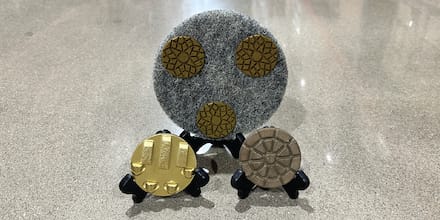When it comes to working with tools, Benjamin Franklin had a common-sense saying that also applies to the diamond tooling under your machine today: “The best investment is in the tools of one’s own trade.” And as it happens, at no point in the concrete polishing process are his words more true than when referring to the actual equipment that makes contact with the concrete itself. For if the tooling isn’t matched to the job, the job won’t go smoothly, no matter what else you might have going for you.
Yet with diamond tooling there are so many variables that the choices can make one’s head spin. Fortunately, the possibilities can be narrowed down by purpose: what exactly do you need the tool to do? What do you want the overall finish of the floor to be? Diamonds are designed to do one of four things very well: remove, grind, hone, or polish. Removal refers to substances on the concrete, like glue, epoxy, or mastic. Grinding means taking the concrete itself down, usually within a range between salt-and-pepper and large, exposed aggregate. Honing and polishing address the finish and shine. Only when the exact purpose has been determined should hardware be chosen.
REMOVAL: An aggressive, metal-bonded tool with fewer, specially-designed and low-grit segments should be used, such as the RSP Trac & Baby Claw PCD’s (both Polycrystalline diamonds), Nitro, or 5-Seg.
GRINDING: Segments tend to increase in number (decrease in aggressiveness) approaching the desired finish, progressing from the RSP 2-Seg, to the Quattro, 10-Seg, and finally, the Turbo Tulip. As always, the bond should be matched to the hardness of the concrete (extra soft – hard).
HONING AND POLISHING: Additional tools, ranging from Copper Transitionals, ceramics, and Hi-Shine pads, offer an array of designs and significantly higher grits to achieve the gloss level desired.
* All the above hardware can be found on the RSP Diamond Tooling Guide for easy reference.
Once you’ve successfully matched tooling to purpose, what’s of equal importance is the quality of the diamond tools themselves. For just like everything else, production standards vary. As a grinding/polishing job is only as good as the people and equipment working it, a diamond tool is only as good as the components that go into its production. That “quality effect” will not only drive a diamond’s longevity, but also consistency across the worksite, and of course, the final result.
Experienced contractors know the reputable brands and stick to what works. But “what works” must also be reliably available to be useful. As for RSP’s proprietary diamond tooling line…it was built FOR the surface prep industry by professionals IN the surface prep industry with over 40 years of combined experience. The tools were designed and tested inhouse, manufactured to the strictest standards in a dedicated facility, and have proven themselves in the field, time and time again. Even better, the entire line is in stock and available for immediate shipping.
Given that one of the most important decisions a surface prep contractor will make on the job is determining what tooling to use, it is crucial to put in the research prior to purchase. Define the intended use and seek out high-quality tools that give consistent, proven results. And as you’re making these important choices regarding your diamond tooling, keep in mind what Thomas Carlyle, the Scottish philosopher once said. “Man is a tool-using animal. Without tools he is nothing, with tools he is all.”
